Effect of Codend Design and Mesh Size on the Size Selectivity and Exploitation Pattern of Three Commercial Fish in Stow Net Fishery of the Yellow Sea, China
Abstract
:1. Introduction
- (1)
- How are the selective properties of the legal codend for the three croaker species?
- (2)
- To what extent can the size selectivity and exploitation pattern of the three croaker species be improved by modifying mesh sizes and shapes in the codend?
- (3)
- What is the optimal codend modification for improving the size selectivity and exploitation pattern of the three croaker species in stow net fisheries in the Yellow Sea?
2. Materials and Methods
2.1. Experimental Survey
2.2. Size Selectivity Analysis
2.3. Estimation of Exploitation Pattern Indicators
3. Results
3.1. Description of Experiments and Catches
3.2. Size Selectivity
3.3. Exploitation Pattern Indicators
4. Discussion
Author Contributions
Funding
Institutional Review Board Statement
Informed Consent Statement
Data Availability Statement
Acknowledgments
Conflicts of Interest
References
- Sun, Z.; Zhou, J.; Wang, J.; Zhao, Z.; Zhuang, S.; Chen, B.; Yan, W. Stow net fishery in the Yellow Sea and Bohai Sea area. Prog. Fish. Sci. 2012, 33, 94–101. [Google Scholar]
- Huang, L.; Chen, Y.; Gao, H.; Xu, Q.; Cheng, H.; Liu, C.; Tang, Y. Study on selectivity of square mesh escape window of Tanzi net. J. Ocean Univ. China 2018, 48, 15–23. [Google Scholar]
- MARA. China Fishery Yearbook 2021; China Agriculture Press: Beijing, China, 2021. [Google Scholar]
- Suuronen, P.; Chopin, F.; Glass, C.; Løkkeborg, S.; Matsushita, Y.; Queirolo, D.; Rihan, D. Low Impact and Fuel Efficient Fishing—Looking beyond the Horizon. Fish. Res. 2012, 119–120, 135–146. [Google Scholar] [CrossRef]
- He, P.; Chopin, F.; Suuronen, P.; Ferro, R.S.T.; Lansley, J. Classification and illustrated definition of fishing gears. In FAO Fisheries and Aquaculture Technical Paper; No. 672; FAO: Rome, Italy, 2021. [Google Scholar]
- MARA. China Fishery Yearbook 2011; China Agriculture Press: Beijing, China, 2011. [Google Scholar]
- MARA. China Fishery Yearbook 2022; China Agriculture Press: Beijing, China, 2022. [Google Scholar]
- Shan, X.; Jin, X.; Dai, F.; Chen, Y.; Yang, T.; Yao, J. Population Dynamics of Fish Species in a Marine Ecosystem: A Case Study in the Bohai Sea, China. Mar. Coast. Fish. 2016, 8, 100–117. [Google Scholar] [CrossRef] [Green Version]
- Kang, B.; Liu, M.; Huang, X.; Li, J.; Yan, Y.; Han, C.; Chen, S. Fisheries in Chinese seas: What can we learn from controversial official fisheries statistics? Rev. Fish Biol. Fish. 2018, 28, 503–519. [Google Scholar] [CrossRef]
- Zhang, J.; Shi, X.; He, P.; Shi, J. Effectiveness of Escape Vent Shape in Crab Pots for Releasing Swimming Crab Portunus Trituberculatus in the East China Sea. Aquac. Fish. 2023, 8, 332–340. [Google Scholar] [CrossRef]
- Xu, G.; Zhu, W.; Xu, L. Gillnet selectivity for swimming crab Portunus trituberculatus in the East China Sea. Fish. Sci. 2021, 87, 31–38. [Google Scholar] [CrossRef]
- Yu, M.; Liu, C.; Tang, Y.; Zhang, L.; Zhao, W. Effects of escape vents on the size selection of whelk (Rapana venosa) and Asian paddle crab (Charybdis japonica) in the small-scale pot fishery of the Yellow Sea, China. Hydrobiologia 2022, 849, 3101–3115. [Google Scholar] [CrossRef]
- Yu, M.; Liu, C.; Sun, L.; Zhang, L.; Tang, Y. A New Concept for Bycatch Reduction in Small-Scale Accordion-Shaped Trap Fisheries of the Yellow Sea, China. Fish. Res. 2023, 263, 106685. [Google Scholar] [CrossRef]
- Sun, M.; Li, Y.; Chen, Y. Unveiling unselective fishing in China: A nationwide meta-analysis of multispecies fisheries. Fish Fish. 2022, 24, 142–158. [Google Scholar] [CrossRef]
- Huang, L.; Gao, H.; Tang, Y.; Liu, C.; Xu, Q.; Sun, P. A study on the selectivity of codend mesh of Tanzi net in Haizhou bay. J. Ocean Univ. China 2016, 46, 143–150. [Google Scholar]
- Jin, X. Long-term changes in fish community structure in the Bohai Sea, China. Estuar. Coast. Shelf Sci. 2004, 59, 163–171. [Google Scholar] [CrossRef]
- Vasilakopoulos, P.; O’Neill, F.G.; Marshall, C. Misspent youth: Does catching immature fish affect fisheries sustainability. ICES J. Mar. Sci. 2011, 68, 1525–1534. [Google Scholar] [CrossRef]
- Cheng, J.; Nguyen Van, Q.; Sasaki, K.; Hoshino, K.; Sakai, T.; Santos, M.; Liu, M.; Yang, C.; Chen, M.; Yeh, H.M.; et al. Larimichthys polyactis. The IUCN Red List of Threatened Species 2020: E.T49182929A49229050. Available online: https://dx.doi.org/10.2305/IUCN.UK.2020-1.RLTS.T49182929A49229050.en (accessed on 16 March 2023). [CrossRef]
- Shen, G.; Heino, M. An overview of marine fisheries management in China. Mar. Policy 2014, 44, 265–272. [Google Scholar] [CrossRef] [Green Version]
- Xu, Q.; Li, X.; Sun, S.; Fan, G. Selectivity of codend mesh of stow nets with double pile vertical hole in Haizhou Bay in autumn. Fish. Sci. 2020, 39, 388–393. [Google Scholar]
- Zhang, J.; Zhang, P.; Shi, J.; Chen, X. Size selectivity of diamond and square mesh codends in single-stake stow net fisheries. Mar. Fish. 2011, 33, 213–220. [Google Scholar]
- Li, C.; Zhang, X.; Chen, P.; Zhang, P. Selectivity of codend mesh sizes in stow nets during spring on the coast of Zhaitang Island, Qingdao. J. Fish. Sci. China 2015, 22, 799–811. [Google Scholar]
- Wileman, D.; Ferro, R.S.T.; Fonteyne, R.; Millar, R.B. Manual of Methods of Measuring the Selectivity of Towed Fishing Gear. ICES Coop. Res. Rep. 1996, 215, 38–99. [Google Scholar]
- Fryer, R.J. A model of between-haul variation in selectivity. ICES J. Mar. Sci. 1991, 48, 281–290. [Google Scholar] [CrossRef]
- Millar, R.B. Incorporation of between-haul variation using bootstrapping and nonparametric estimation of selection curves. Fish. Bull. 1993, 91, 564–572. [Google Scholar]
- Xu, Q.; Li, X.; Sun, S.; Zhang, X. Studies on the cod-end mesh selectivity of pelagic pair trawls in Yellow Sea. J. Ocean Univ. China 2020, 50, 53–60. [Google Scholar]
- Herrmann, B.; Krag, L.A.; Feekings, J.; Noack, T. Understanding and predicting size selection in diamond-mesh cod ends for Danish seining: A study based on sea trials and computer simulations. Mar. Coast. Fish. 2016, 8, 277–291. [Google Scholar] [CrossRef] [Green Version]
- Akaike, H. A new look at the statistical model identification. IEE Trans. Automat. Contr. 1974, 19, 716–723. [Google Scholar] [CrossRef]
- Herrmann, B.; Sistiaga, M.; Nielsen, K.N.; Larsen, R.B. Understanding the size selectivity of redfish (Sebastes spp.) in north atlantic trawl codends. J. Northwest Atl. Fish. Sci. 2012, 44, 1–13. [Google Scholar] [CrossRef] [Green Version]
- Efron, B. The jackknife, the bootstrap and other resampling plans. In SIAM Monograph No. 38, CBSM-NSF Regional Conference Series in Applied Mathematics; SIMA: Philadelphia, PA, USA, 1982. [Google Scholar]
- Herrmann, B.; Krag, L.A.; Krafft, B.A. Size selection of Antarctic krill (Euphausia superba) in a commercial codend and trawl body. Fish. Res. 2018, 207, 49–54. [Google Scholar] [CrossRef]
- Herrmann, B.; Sitiaga, M.; Larsen, R.B.; Brinkhof, J. Effect of three different codend designs on the size selectivity of juvenile cod in the Barents Sea shrimp trawl fishery. Fish. Res. 2019, 219, 105337. [Google Scholar] [CrossRef]
- Yang, B.; Yang, L.; Tan, Y.; Yan, L.; Zhang, P.; Li, J. Size Selectivity of Combined Square and Diamond Mesh Codends of Shrimp Beam Trawl for Banded Scad Caranx (Atule) Kalla in the Northern South China Sea. J. Oceanol. Limnol. 2018, 36, 1880–1890. [Google Scholar] [CrossRef]
- Sala, A.; Lucchetti, A.; Piccinetti, C.; Ferretti, M. Size Selection by Diamond- and Square-Mesh Codends in Multi-Species Mediterranean Demersal Trawl Fisheries. Fish. Res. 2008, 93, 8–21. [Google Scholar] [CrossRef]
- Guijarro, B.; Massutí, E. Selectivity of diamond- and square-mesh codends in the deepwater crustacean trawl fishery off the Balearic Islands (western Mediterranean). ICES J. Mar. Sci. 2006, 63, 52–67. [Google Scholar] [CrossRef]
- Wang, Z.; Gao, Z.; Zhang, J. Selectivity study on Y-shaped exclusion device for mantis shrimp and swimming crab in Chinese stow net. South China Fish. Sci. 2017, 13, 117–123. [Google Scholar]
- Chen, D. Fishery Ecology in Yellow Sea and Bo Hai Sea; China Ocean Press: Beijing, China, 1991. [Google Scholar]
- Brinkhof, J.; Sistiaga, M.; Herrmann, B.; Grimaldo, E.; Larsen, R.B. Managing size selectivity: The relevance of compulsory and alternative selection devices in the Northeast Atlantic bottom trawl fishery. ICES J. Mar. Sci. 2022, 79, 2399–2412. [Google Scholar] [CrossRef]
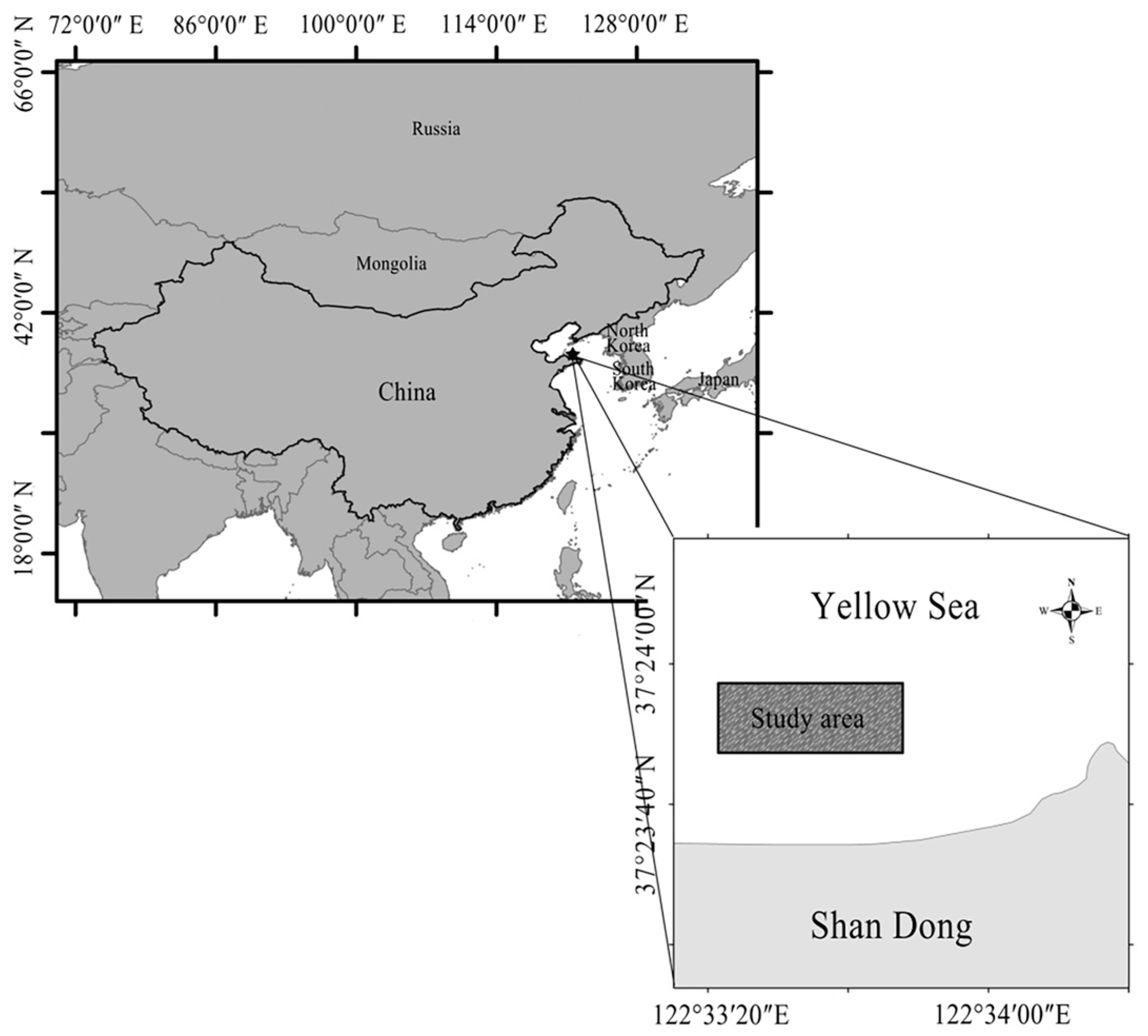
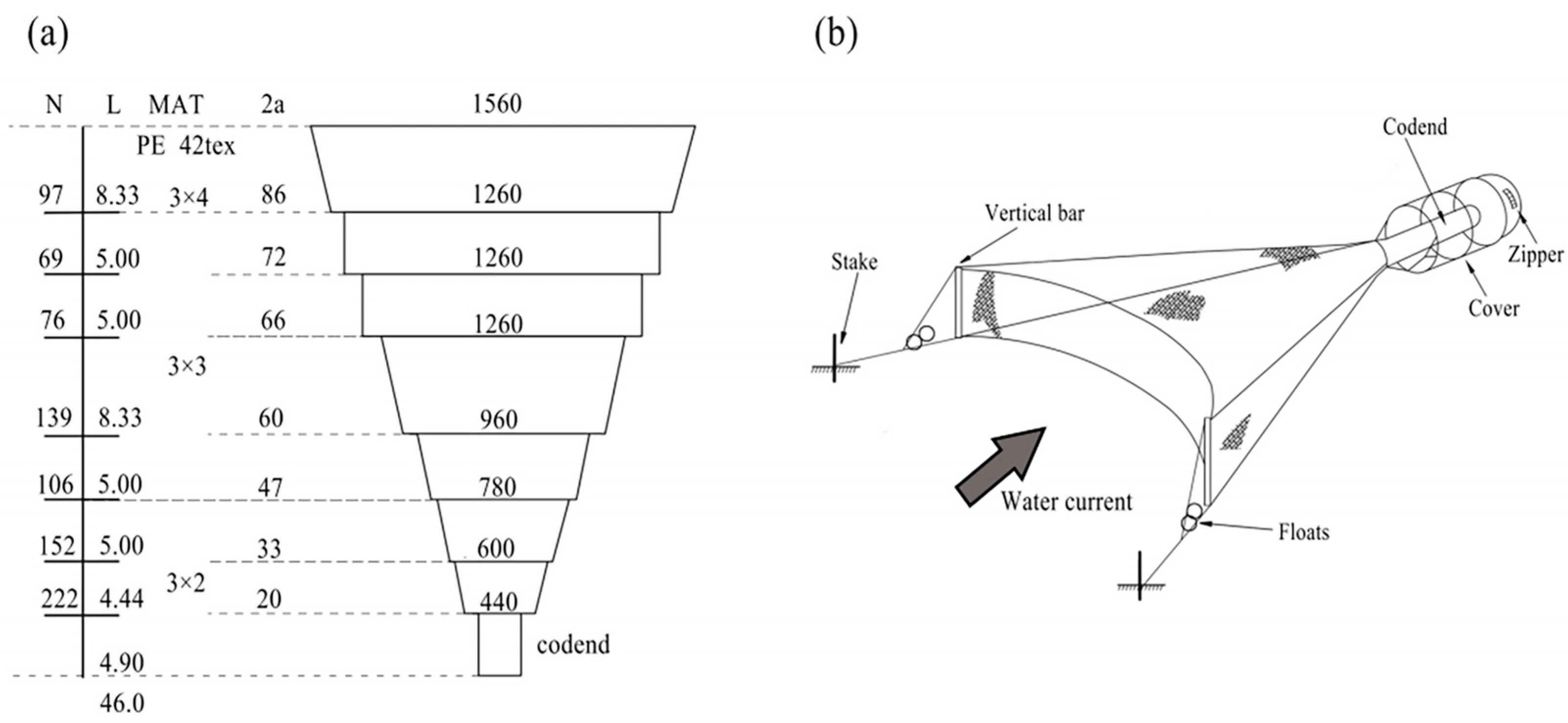



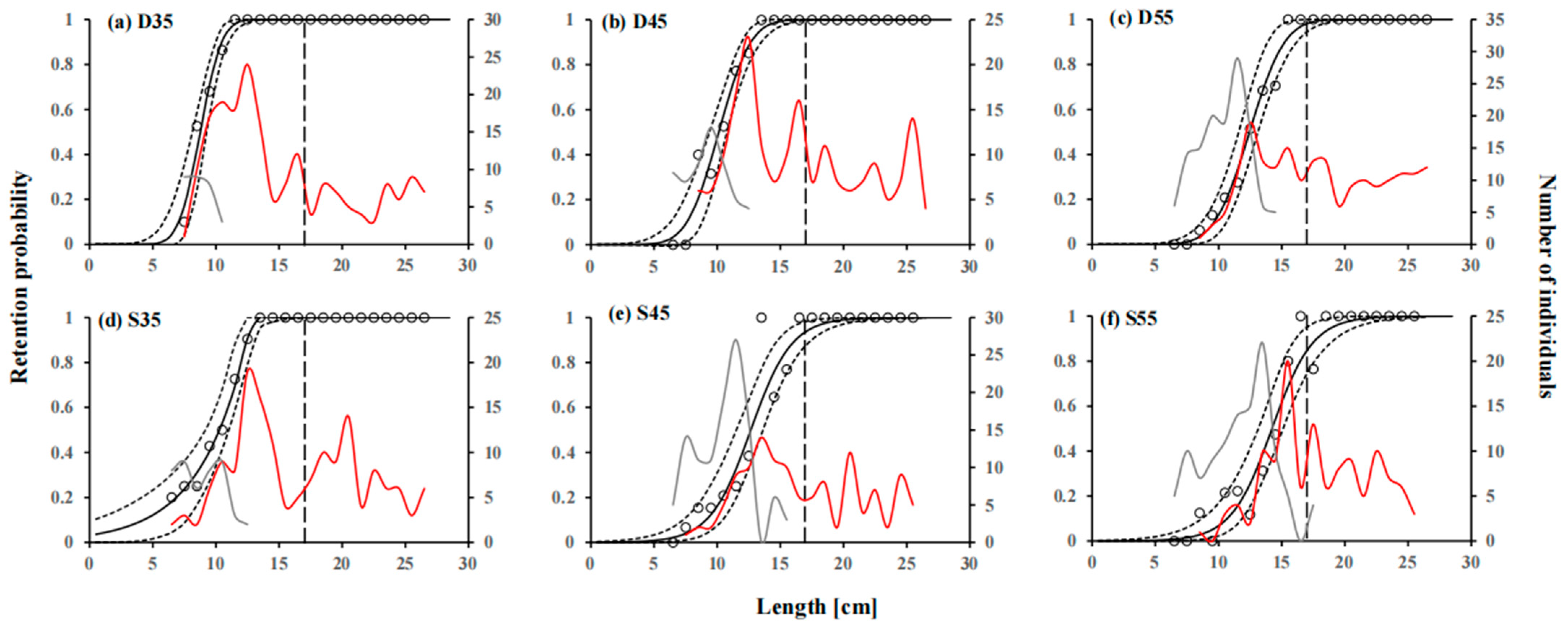
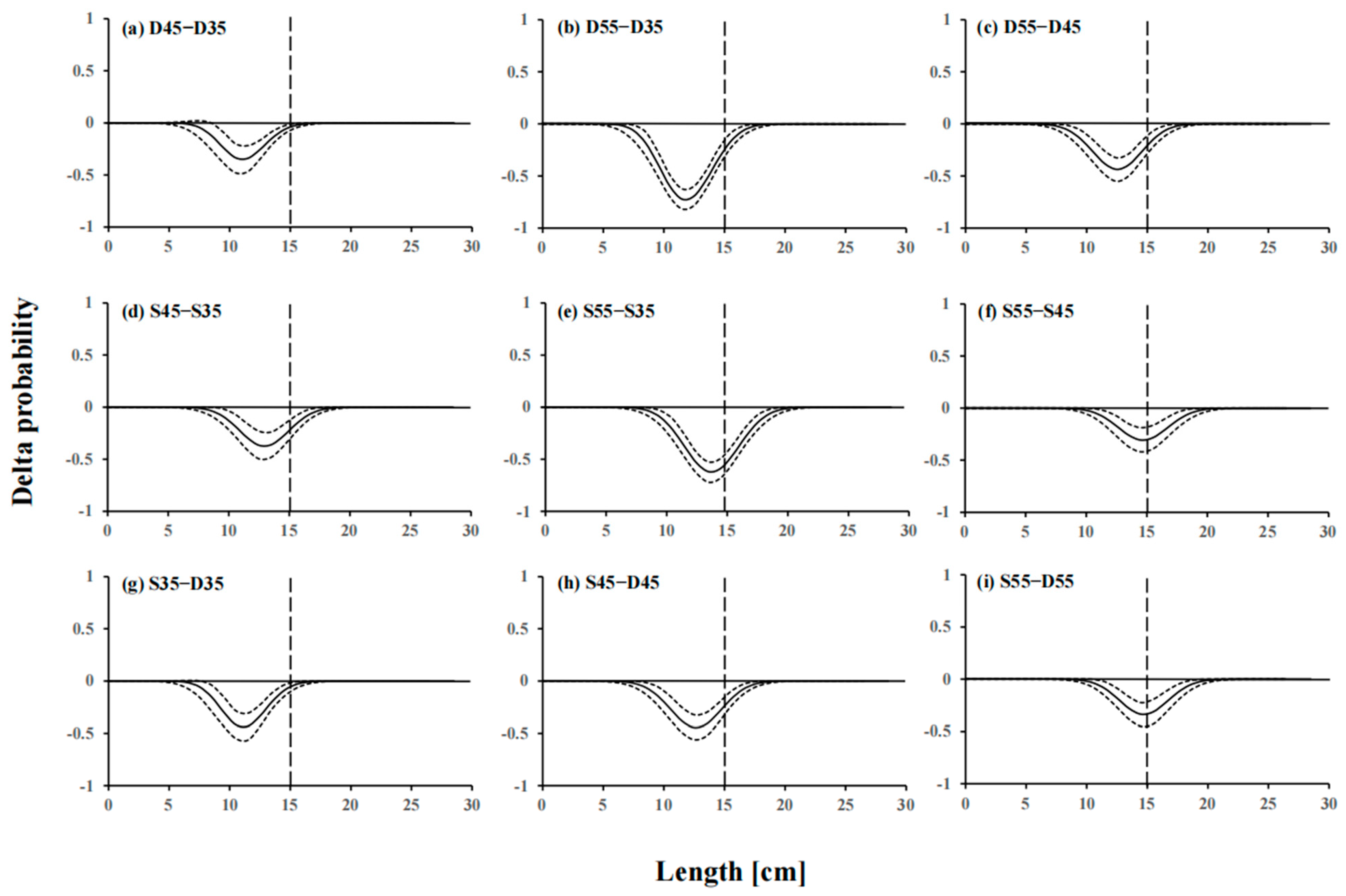
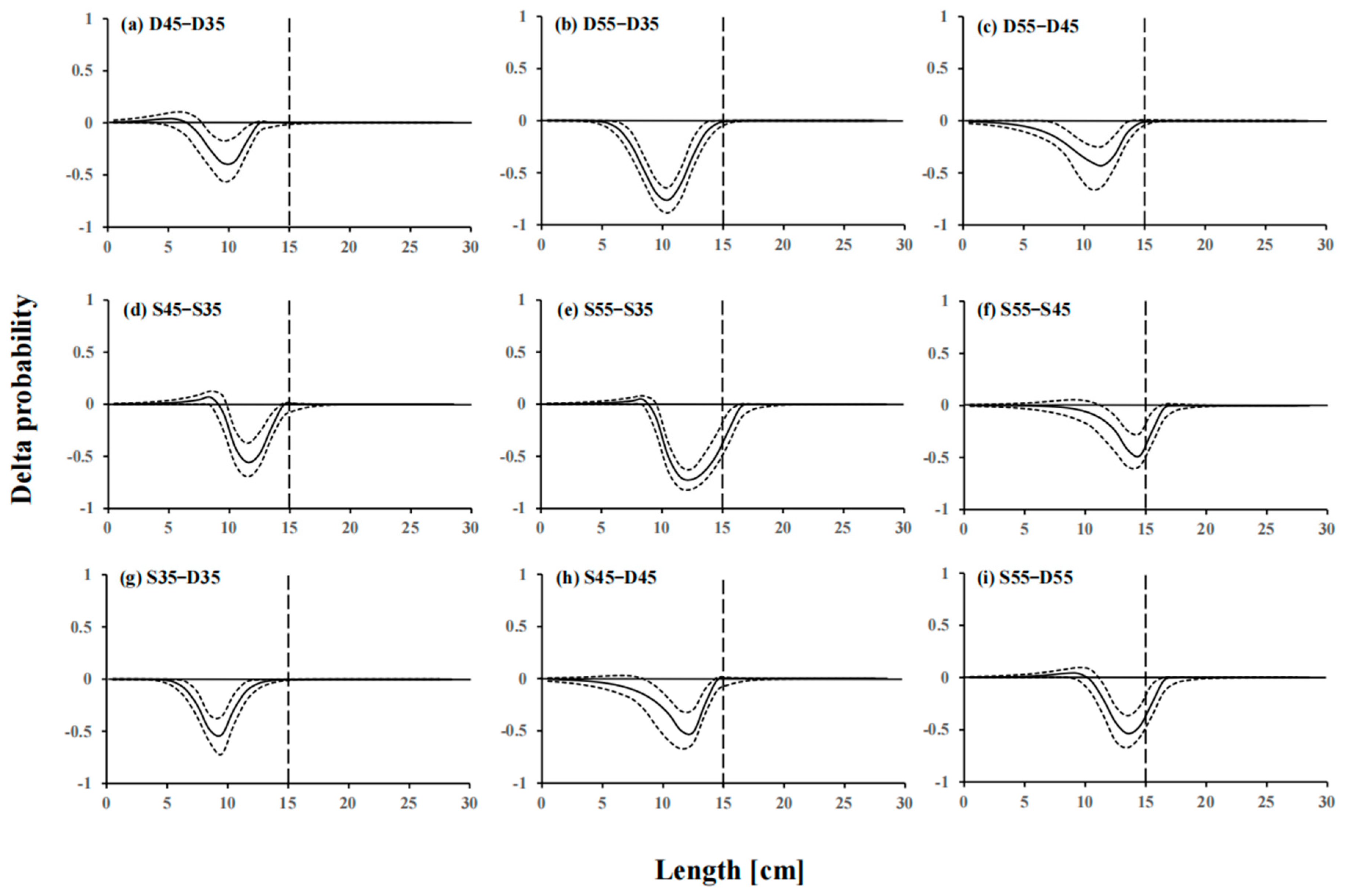

| Codend | Mesh Size ± SD (mm) | Twine Diameter ± SD (mm) | Mesh Number in Circumference | Mesh Number in Length |
|---|---|---|---|---|
| D35 | 35.72 ± 0.89 | 1.23 ± 0.17 | 246 | 137 |
| D45 | 44.60 ± 0.67 | 1.18 ± 0.09 | 197 | 110 |
| D55 | 55.18 ± 0.70 | 1.10 ± 0.10 | 159 | 89 |
| S35 | 35.09 ± 1.01 | 1.15 ± 0.14 | 150 | 266 |
| S45 | 44.30 ± 0.35 | 1.21 ± 0.09 | 119 | 211 |
| S55 | 54.61 ± 0.53 | 1.16 ± 0.23 | 97 | 171 |
| cover | 14.58 ± 0.32 | 1.08 ± 0.11 | 495 | 831 |
| Data Specification | Codends | |||||
|---|---|---|---|---|---|---|
| D35 | D45 | D55 | S35 | S45 | S55 | |
| Depth (m) | 20–22 | 21–23 | 18–21 | 19–22 | 23–25 | 22–25 |
| Soak times (h) | 22–24 | 23–24 | 24–25 | 22–25 | 23–25 | 23–26 |
| Little yellow croaker | ||||||
| No. of hauls | 10 | 10 | 9 | 9 | 8 | 10 |
| No. of individuals in codend | 270 | 269 | 196 | 231 | 194 | 193 |
| No. of individuals in cover | 68 | 119 | 152 | 121 | 160 | 224 |
| Sub-sampling factor in codend | 0.50–1.00 | 1.00–1.00 | 1.00–1.00 | 1.00–1.00 | 1.00–1.00 | 1.00–1.00 |
| Sub-sampling factor in cover | 0.50–1.00 | 1.00–1.00 | 1.00–1.00 | 1.00–1.00 | 1.00–1.00 | 0.50–1.00 |
| Length range (cm) | 7.3–25.7 | 7.2–25.9 | 7.1–25.5 | 7.2–25.6 | 7.6–25.8 | 7.5–25.4 |
| Weight range (g) | 3.7–136.2 | 3.8–135.3 | 3.7–133.0 | 3.9–134.3 | 3.6–135.7 | 3.4–129.4 |
| Silver croaker | ||||||
| No. of hauls | 8 | 9 | 8 | 9 | 7 | 8 |
| No. of individuals in codend | 160 | 142 | 127 | 163 | 124 | 97 |
| No. of individuals in cover | 54 | 59 | 71 | 66 | 92 | 129 |
| Sub-sampling factor in codend | 1.00–1.00 | 1.00–1.00 | 1.00–1.00 | 1.00–1.00 | 1.00–1.00 | 1.00–1.00 |
| Sub-sampling factor in cover | 1.00–1.00 | 1.00–1.00 | 1.00–1.00 | 1.00–1.00 | 1.00–1.00 | 1.00–1.00 |
| Length range (cm) | 5.4–23.2 | 5.8–24.9 | 5.2–24.4 | 6.6–23.8 | 6.3–24.6 | 5.1–24.7 |
| Weight range (g) | 1.2–138.9 | 1.7–178.1 | 1.1–176.0 | 2.4–170.3 | 1.8–165.3 | 1.0–179.1 |
| Flower croaker | ||||||
| No. of hauls | 7 | 8 | 9 | 7 | 7 | 8 |
| No. of individuals in codend | 150 | 137 | 157 | 139 | 125 | 110 |
| No. of individuals in cover | 29 | 55 | 102 | 45 | 90 | 93 |
| Sub-sampling factor in codend | 0.50–1.00 | 0.50–1.00 | 0.50–1.00 | 0.50–1.00 | 1.00–1.00 | 0.50–1.00 |
| Sub-sampling factor in cover | 1.00–1.00 | 1.00–1.00 | 0.50–1.00 | 1.00–1.00 | 0.50–1.00 | 0.50–1.00 |
| Length range (cm) | 7.5–26.6 | 6.2–26.4 | 6.6–26.9 | 6.1–26.2 | 6.5–25.7 | 6.8–25.8 |
| Weight range (g) | 3.9–220.0 | 1.6–221.2 | 2.4–217.6 | 1.2–217.0 | 3.2–212.3 | 2.6–195.3 |
| Species | Codends | Models | |||
|---|---|---|---|---|---|
| Logit | Probit | Gompertz | Richards | ||
| Little yellow croaker | D35 | 204.63 | 203.93 | 207.08 | 206.63 |
| D45 | 273.87 | 271.87 | 274.22 | 275.75 | |
| D55 | 234.43 | 232.25 | 234.98 | 236.26 | |
| S35 | 217.43 | 215.97 | 217.90 | 219.13 | |
| S45 | 264.82 | 262.64 | 264.22 | 265.95 | |
| S55 | 319.21 | 317.29 | 325.23 | 320.88 | |
| Silver croaker | D35 | 112.64 | 111.70 | 113.29 | 114.64 |
| D45 | 112.05 | 111.04 | 115.42 | 110.79 | |
| D55 | 87.49 | 86.63 | 87.84 | 89.39 | |
| S35 | 96.74 | 96.33 | 95.75 | 97.75 | |
| S45 | 147.77 | 146.72 | 151.25 | 145.03 | |
| S55 | 150.44 | 149.63 | 156.26 | 146.38 | |
| Flower croaker | D35 | 89.00 | 88.24 | 89.23 | 90.99 |
| D45 | 128.31 | 127.30 | 129.28 | 130.02 | |
| D55 | 204.20 | 203.28 | 210.46 | 205.07 | |
| S35 | 113.22 | 112.36 | 118.04 | 109.01 | |
| S45 | 190.15 | 190.26 | 196.98 | 190.96 | |
| S55 | 182.27 | 182.56 | 190.21 | 182.91 |
| Species | Parameters | Codends | |||||
|---|---|---|---|---|---|---|---|
| D35 | D45 | D55 | S35 | S45 | S55 | ||
| Little yellow croaker | Model | Probit | Probit | Probit | Probit | Probit | Probit |
| L50 (cm) | 9.92 (9.43–10.35) | 11.51 (11.02–11.96) | 13.73 (13.33–14.09) | 11.95 (11.48–12.38) | 13.84 (13.41–14.28) | 15.41 (14.98–15.82) | |
| SR (cm) | 2.16 (1.62–2.84) | 2.68 (2.20–3.22) | 2.51 (2.00–3.00) | 2.58 (1.98–3.16) | 2.64 (2.08–3.14) | 2.71 (2.19–3.22) | |
| p-value | >0.9999 | 0.9933 | 0.9983 | 0.9991 | 0.9967 | 0.9682 | |
| Deviance | 1.78 | 5.99 | 4.8 | 4.35 | 5.33 | 7.92 | |
| DOF | 17 | 17 | 17 | 17 | 17 | 17 | |
| Silver croaker | Model | Probit | Richards | Probit | Gompertz | Richards | Richards |
| L50 (cm) | 8.54 (8.07–9.05) | 10.38 (9.29–10.87) | 11.96 (11.49–12.38) | 10.24 (9.91–10.56) | 12.60 (11.71–13.00) | 14.47 (13.45–14.99) | |
| SR (cm) | 2.11 (1.52–2.61) | 2.62 (1.56–3.56) | 1.80 (1.19–2.28) | 1.80 (1.19–2.28) | 2.30 (1.54–3.09) | 2.78 (1.93–3.72) | |
| δ | 0.10 (0.10–100.00) | 0.10 (0.10–100.00) | 0.10 (0.10–1.91) | ||||
| p-value | >0.9999 | 0.9985 | >0.9999 | >0.9999 | 0.9953 | 0.9991 | |
| Deviance | 2.34 | 4.69 | 2.58 | 1.14 | 5.09 | 4.32 | |
| DOF | 17 | 17 | 18 | 16 | 16 | 17 | |
| Flower croaker | Model | Probit | Probit | Probit | Richards | Logit | Logit |
| L50 (cm) | 8.76 (8.16–9.30) | 10.12 (9.44–10.77) | 12.45 (11.60–13.12) | 10.28 (9.19–11.01) | 12.66 (11.51–13.61) | 14.23 (13.18–15.13) | |
| SR (cm) | 1.80 (1.23–2.56) | 2.67 (1.79–3.72) | 2.94 (2.03–3.68) | 4.10 (2.23–6.09) | 3.54 (2.52–4.52) | 3.54 (2.37–4.87) | |
| δ | 0.10 (0.10–0.73) | ||||||
| p-value | >0.9999 | 0.9978 | 0.9977 | >0.9999 | 0.3257 | 0.6153 | |
| Deviance | 2.45 | 6.04 | 6.08 | 0.32 | 20.13 | 15.67 | |
| DOF | 18 | 19 | 19 | 18 | 18 | 18 |
| Species | Indicators | Codends | |||||
|---|---|---|---|---|---|---|---|
| D35 | D45 | D55 | S35 | S45 | S55 | ||
| Little yellow croaker | nP− (%) | 77.52 (72.84–81.95) | 57.74 (51.56–63.86) | 27.61 (22.38–33.67) | 52.03 (45.85–58.51) | 26.53 (20.41–32.85) | 11.03 (7.48–15.25) |
| nP+ (%) | 100.00 (99.93–100.00) | 99.44 (98.71–99.84) | 95.22 (92.65–97.77) | 99.20 (98.12–99.81) | 94.20 (91.52–96.73) | 83.28 (78.68–88.10) | |
| nRatio | 1.39 (1.21–1.57) | 1.04 (0.88–1.20) | 0.52 (0.41–0.64) | 0.94 (0.80–1.11) | 0.51 (0.39–0.64) | 0.24 (0.16–0.32) | |
| ndRatio (%) | 58.20 (54.84–61.07) | 51.05 (46.90–54.64) | 34.25 (29.11–39.04) | 48.51 (44.43–52.71) | 33.59 (28.28–38.96) | 19.22 (13.78–24.53) | |
| wP− (%) | 88.88 (85.30–91.64) | 71.05 (65.21–76.70) | 37.72 (31.17–44.92) | 65.60 (59.29–72.36) | 36.14 (28.60–43.49) | 15.74 (10.93–21.19) | |
| wP+ (%) | 100.00 (99.96–100.00) | 99.70 (99.28–99.92) | 97.36 (95.80–98.83) | 99.57 (98.95–99.90) | 96.76 (95.06–98.24) | 90.23 (86.94–93.33) | |
| Silver croaker | nP− (%) | 76.02 (70.30–81.15) | 60.54 (53.35–67.90) | 34.89 (28.28–42.12) | 55.99 (50.45–61.99) | 33.01 (26.19–41.11) | 16.72 (11.10–22.80) |
| nP+ (%) | 100.00 (100.00–100.00) | 100.00 (99.74–100.00) | 99.93 (99.60–100.00) | 99.97 (99.82–100.00) | 100.00 (98.44–100.00) | 95.66 (92.00–98.91) | |
| nRatio | 1.58 (1.33–1.90) | 1.25 (1.03–1.53) | 0.72 (0.55–0.93) | 1.16 (0.95–1.41) | 0.68 (0.52–0.91) | 0.36 (0.23–0.51) | |
| ndRatio (%) | 61.17 (57.16–65.46) | 55.64 (50.62–60.46) | 41.97 (35.61–48.10) | 53.71 (48.79–58.43) | 40.62 (34.10–47.64) | 26.59 (18.80–33.92) | |
| wP− (%) | 92.10 (88.78–94.69) | 81.47 (76.34–86.31) | 57.56 (49.55–66.17) | 79.81 (74.84–84.31) | 52.46 (45.02–61.04) | 25.90 (18.52–35.05) | |
| wP+ (%) | 100.00 (100.00–100.00) | 100.00 (99.87–100.00) | 99.97 (99.82–100.00) | 99.98 (99.91–100.00) | 100.00 (99.17–100.00) | 98.07 (96.20–99.53) | |
| Flower croaker | nP− (%) | 82.37 (77.14–87.09) | 67.44 (59.87–74.21) | 41.33 (33.32–51.51) | 69.43 (61.63–76.71) | 40.05 (30.93–51.56) | 25.60 (18.33–36.21) |
| nP+ (%) | 100.00 (100.00–100.00) | 100.00 (99.96–100.00) | 99.83 (99.24–100.00) | 100.00 (99.98–100.00) | 98.80 (97.06–99.76) | 96.96 (93.40–99.39) | |
| nRatio | 1.90 (1.54–2.35) | 1.56 (1.22–1.95) | 0.95 (0.71–1.29) | 1.60 (1.27–2.01) | 0.93 (0.69–1.29) | 0.61 (0.42–0.91) | |
| ndRatio (%) | 65.51 (60.61–70.17) | 60.86 (54.98–66.05) | 48.84 (41.44–56.32) | 61.56 (55.99–66.83) | 48.31 (40.82–56.36) | 37.85 (29.75–47.67) | |
| wP− (%) | 94.99 (92.97–96.50) | 85.48 (80.09–89.51) | 62.47 (53.95–73.14) | 86.21 (81.08–91.05) | 58.87 (48.05–70.23) | 41.65 (31.77–53.52) | |
| wP+ (%) | 100.00 (100.00–100.00) | 100.00 (99.98–100.00) | 99.92 (99.61–100.00) | 100.00 (99.99–100.00) | 99.31 (98.16–99.87) | 98.23 (95.79–99.68) |
Disclaimer/Publisher’s Note: The statements, opinions and data contained in all publications are solely those of the individual author(s) and contributor(s) and not of MDPI and/or the editor(s). MDPI and/or the editor(s) disclaim responsibility for any injury to people or property resulting from any ideas, methods, instructions or products referred to in the content. |
© 2023 by the authors. Licensee MDPI, Basel, Switzerland. This article is an open access article distributed under the terms and conditions of the Creative Commons Attribution (CC BY) license (https://creativecommons.org/licenses/by/4.0/).
Share and Cite
Yu, M.; Herrmann, B.; Liu, C.; Zhang, L.; Tang, Y. Effect of Codend Design and Mesh Size on the Size Selectivity and Exploitation Pattern of Three Commercial Fish in Stow Net Fishery of the Yellow Sea, China. Sustainability 2023, 15, 6583. https://doi.org/10.3390/su15086583
Yu M, Herrmann B, Liu C, Zhang L, Tang Y. Effect of Codend Design and Mesh Size on the Size Selectivity and Exploitation Pattern of Three Commercial Fish in Stow Net Fishery of the Yellow Sea, China. Sustainability. 2023; 15(8):6583. https://doi.org/10.3390/su15086583
Chicago/Turabian StyleYu, Mengjie, Bent Herrmann, Changdong Liu, Liyou Zhang, and Yanli Tang. 2023. "Effect of Codend Design and Mesh Size on the Size Selectivity and Exploitation Pattern of Three Commercial Fish in Stow Net Fishery of the Yellow Sea, China" Sustainability 15, no. 8: 6583. https://doi.org/10.3390/su15086583
APA StyleYu, M., Herrmann, B., Liu, C., Zhang, L., & Tang, Y. (2023). Effect of Codend Design and Mesh Size on the Size Selectivity and Exploitation Pattern of Three Commercial Fish in Stow Net Fishery of the Yellow Sea, China. Sustainability, 15(8), 6583. https://doi.org/10.3390/su15086583






